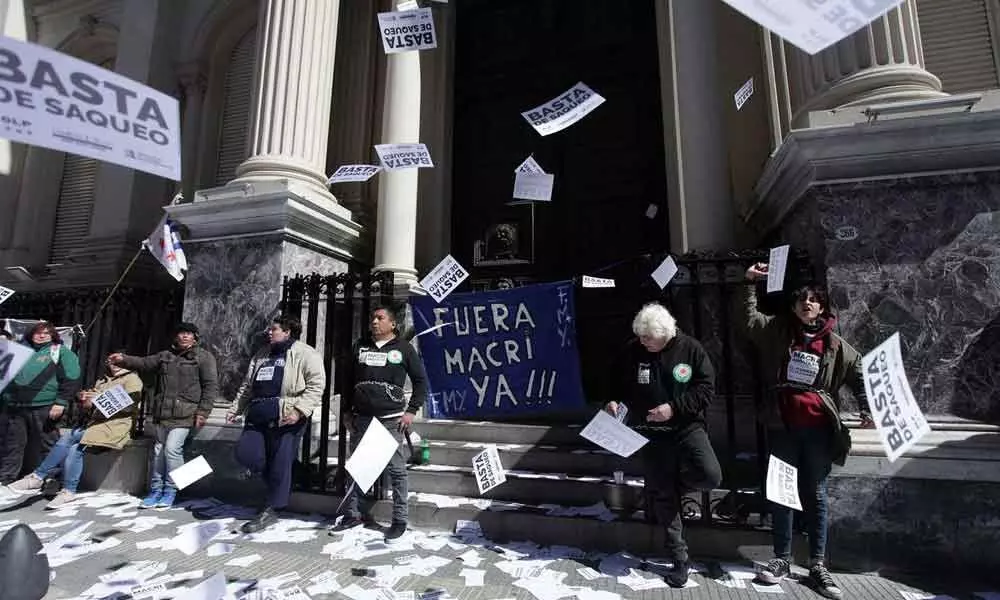Live
- Neha Bhasin rocks with her debut rap song
- Moong Dal Ki Kachori: A delightful crispy treat
- Vivo Warns the Risks of UV-Cured Screen Protectors; Check Vivo's Recommendations
- BJP, Congress turncoats in AAP's first list
- Adani tried to enter Delhi's power sector: AAP's Sanjay
- International Kabaddi Federation sanctions World Super Kabaddi League 2025
- Pollution crisis fuels demand for CNG, BS-6 vehicles during wedding season
- Solar panels empowering UP farmers, says Yogi
- Bomb cyclone leaves hundreds of thousands without power in US
- Is Pushpa-2 Postponed Again? Here’s What Makers Said
Just In
Argentina, country of economic crises


Alberto Fernandez, the newly-elected President of Argentina, has declared that his South American country is in 'virtual default'.
Alberto Fernandez, the newly-elected President of Argentina, has declared that his South American country is in 'virtual default'.
That's a virtual admission that Argentina is in deep economic crisis and is not in a position to honour its external debt obligations. Macroeconomic indicators also paint similar picture.
The South American country is suffering from a whopping 55 per cent inflation. For the last 18 months, its economy has been in crisis in the wake of crash in its currency peso's value.
Estimates reveal that the Argentine economy is likely to contract by a disappointing 3.1 per cent this calendar year. In 2018, GDP went down by 2.51 per cent. And the country is reeling under a debt pile of $330 billion.
International Monetary Fund (IMF) pumped in a staggering $44 billion to stabilise the economy. Sadly, the country's debt accounts for almost 90 per cent of GDP ($445 billion).
That's a clear indication where the country is heading now.
No surprise Argentina postponed its debt obligation of $9 billion, which matured, to August next year, triggering sovereign rating downgrades by global rating agencies like S&P.
But economic crises are not new to the South American country. Since its Independence from Spain in 1916, it defaulted on debt obligation eight times. Double digit inflation is a norm there.
There were also instances when inflation reigned as high as 5000 per cent, leading to economic chaos and steep currency devaluations.
Argentina went through Great Economic Depression for 15 years from 1975 to 1990. During this difficult period, the country's per capita income fell by 20 per cent.
That way, its three decades of economic development went down the drain. Inflation skyrocketed by 300 per cent every year and prices went up by 20 billion times during this period.
After a few years of growth, Argentina again slipped into severe recession in 1998. During this recessionary period which continued till 2002, its economy contracted by a staggering 28 per cent, resulting in widespread unemployment and riots. The country defaulted on external debt of $100 billion.
However, Argentina's economy came back with a bang soon after, registering nine per cent upswing for five years from 2003.
This 'resurrection' in its GDP took many pundits by surprise even as the economy reached pre-crisis levels two years later. The country cleared all IMF loans by 2006.
The current economic situation in Argentina could be gauged from the fact that President Fernandez compared it with the 1998-2002 crisis.
That means Argentina is in for a long haul when it comes to reviving its economic growth. This country's economy is paradoxical in nature.
It clocked enormous growth in early 20th century before taking U-turn and going in reverse direction - a phenomenon described by many as Argentina Paradox.
Despite all the crises and bouts of hyperinflation, Argentina is a not poor country. Its per capita income stands at a decent $9,887, more than four times that of India.
As per latest numbers, India's per capita income is still languishing at $2,172. That's the Indian Paradox!
As for Argentina, it may spring a surprising economic growth a few years down the line.

© 2024 Hyderabad Media House Limited/The Hans India. All rights reserved. Powered by hocalwire.com






